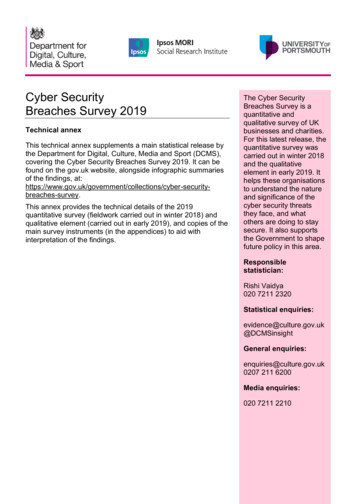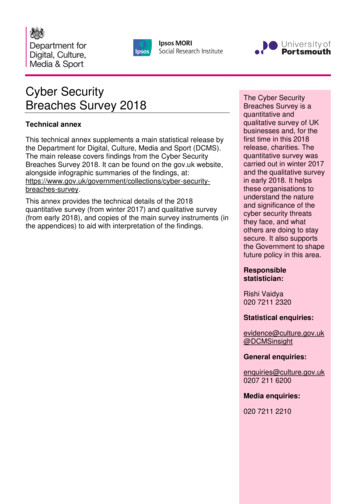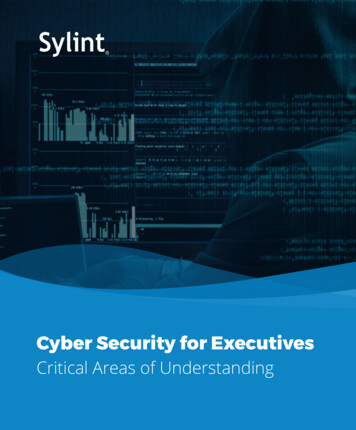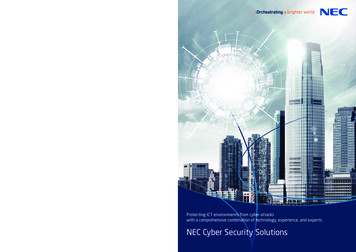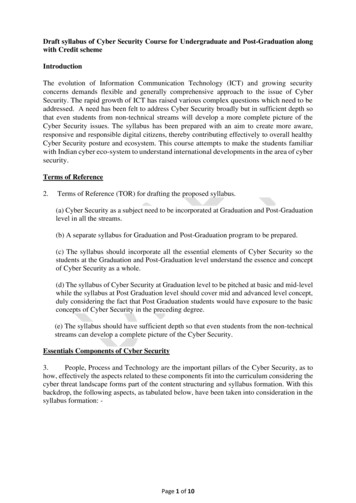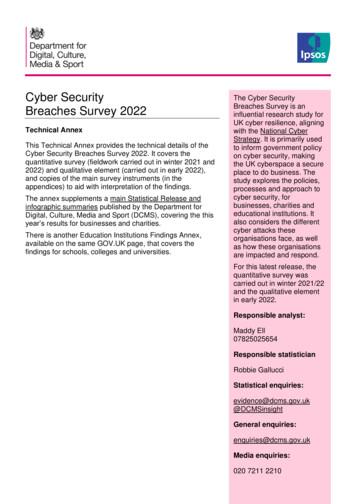
Transcription
Cyber SecurityBreaches Survey 2022Technical AnnexThis Technical Annex provides the technical details of theCyber Security Breaches Survey 2022. It covers thequantitative survey (fieldwork carried out in winter 2021 and2022) and qualitative element (carried out in early 2022),and copies of the main survey instruments (in theappendices) to aid with interpretation of the findings.The annex supplements a main Statistical Release andinfographic summaries published by the Department forDigital, Culture, Media and Sport (DCMS), covering the thisyear’s results for businesses and charities.There is another Education Institutions Findings Annex,available on the same GOV.UK page, that covers thefindings for schools, colleges and universities.The Cyber SecurityBreaches Survey is aninfluential research study forUK cyber resilience, aligningwith the National CyberStrategy. It is primarily usedto inform government policyon cyber security, makingthe UK cyberspace a secureplace to do business. Thestudy explores the policies,processes and approach tocyber security, forbusinesses, charities andeducational institutions. Italso considers the differentcyber attacks theseorganisations face, as wellas how these organisationsare impacted and respond.For this latest release, thequantitative survey wascarried out in winter 2021/22and the qualitative elementin early 2022.Responsible analyst:Maddy Ell07825025654Responsible statisticianRobbie GallucciStatistical enquiries:evidence@dcms.gov.uk@DCMSinsightGeneral enquiries:enquiries@dcms.gov.ukMedia enquiries:020 7211 2210
Department for Digital, Culture, Media and SportCyber Security Breaches Survey 2022: Technical AnnexContentsChapter 1: Overview . 11.1 Summary of methodology . 11.2 Strengths and limitations of the survey. 11.3 Changes from previous waves . 21.4 Comparability to the pre-2016 Information Security Breaches Surveys. 4Chapter 2: Survey approach technical details . 62.1 Survey and questionnaire development . 62.2 Survey microsite and GOV.UK page . 92.3 Sampling . 92.4 Fieldwork . 152.5 Fieldwork outcomes and response rate. 182.6 Data processing and weighting . 222.7 SPSS data uploaded to UK Data Archive . 242.8 Points of clarification on the data . 29Chapter 3: Qualitative approach technical details . 303.1 Sampling . 303.2 Recruitment quotas and screening . 303.3 Fieldwork . 313.4 Analysis . 32Chapter 4: Research burden . 33Appendix A: Questionnaire. 34Appendix B: Help card offered to survey respondents . 59Appendix C: Topic guide. 61Appendix D: Further information . 68
Department for Digital, Culture, Media and SportCyber Security Breaches Survey 2022: Technical Annex1Chapter 1: Overview1.1 Summary of methodologyAs in previous years, there were two strands to the Cyber Security Breaches Survey 2022: We undertook a random probability telephone survey of 1,243 UK businesses, 424 UKregistered charities and 490 education institutions from 20 September 2021 to 21 January2022. The data for businesses and charities have been weighted to be statisticallyrepresentative of these two populations. We carried out 35 in-depth interviews across December 2021 and January 2022, to gainfurther qualitative insights from some of the organisations that answered the survey.Sole traders and public-sector organisations were outside the scope of the study.1.2 Strengths and limitations of the surveyWhile there have been other surveys about cyber security in organisations in recent years,these have often been less applicable to the typical UK business or charity for severalmethodological reasons, including: focusing on larger organisations employing cyber security or IT professionals, at theexpense of small organisations (with under 50 staff) that make up the overwhelmingmajority, and may not employ a professional in this role covering several countries alongside the UK, which leads to a small sample size of UKorganisations using partially representative sampling or online-only data collection methods.By contrast, the Cyber Security Breaches Survey series is intended to be statisticallyrepresentative of UK businesses of all sizes and all relevant sectors, and of UK registeredcharities in all income bands.The 2022 survey shares the same strengths as previous surveys in the series: the use of random probability sampling and interviewing to avoid selection bias the inclusion of micro and small businesses, and low-income charities, which ensures thatthe respective findings are not skewed towards larger organisations a telephone data collection approach, which aims to also include businesses and charitieswith less of an online presence (compared to online-only surveys) a comprehensive attempt to obtain accurate cost data from respondents, givingrespondents flexibility in how they can answer (e.g. allowing numeric and bandedamounts), and sending them a follow-up online survey to validate answers given intelephone interviews a consideration of the cost of cyber security breaches beyond the immediate direct costs(i.e. explicitly asking respondents to consider longer-term direct costs, staff time costs, aswell as other indirect costs, while giving a description of what might be included withineach of these cost categories).
Department for Digital, Culture, Media and SportCyber Security Breaches Survey 2022: Technical Annex2At the same time, while this survey aims to produce the most representative, accurate andreliable data possible with the resources available, it should be acknowledged that there areinevitable limitations of the data, as with any survey project. The following might be consideredthe main limitations: Organisations can only tell us about the cyber security breaches or attacks that they havedetected. There may be other breaches or attacks affecting organisations, but which arenot identified as such by their systems or by staff, such as a virus or other malicious codethat has so far gone unnoticed. Therefore, the survey may have a tendency tosystematically underestimate the real level of breaches or attacks. As we allude to in themain Statistical Release, this could be a more significant limitation this year, sinceorganisations may have had less oversight of their staff during the COVID-19 pandemic. The business survey intends to represent businesses of all sizes. As the BEIS BusinessPopulation Estimates 2021 show, the UK business population is predominantly made up ofmicro and small businesses. This presents a challenge – these businesses, due to theirsmaller scale and resource limitations, typically have a less mature cyber security profile.This may limit the insights this study in isolation can generate into the more sophisticatedcyber security issues and challenges facing the UK’s large business population, and thekinds of high-impact cyber security incidents that appear in the news and media.Nevertheless, the study design attempts to balance this by boosting survey responsesamong medium and large businesses (and high-income charities) and by focusing onlarger organisations in the qualitative strand. Moreover, DCMS undertakes a separatesurvey series focused on larger organisations, the Cyber Security Longitudinal Survey,partly to address this limitation. Organisations may be inclined to give answers that reflect favourably on them in surveysabout cyber security (a form of social desirability bias), given the common perceptions ofreputational damage associated with cyber security incidents. Furthermore, organisationsthat have suffered from more substantial cyber security incidents may be less inclined totake part because of this. This may result in surveys like this one undercounting the trueextent and cost of cyber security incidents. However, we make a concerted effort toovercome this in the administration of the survey. We make it clear to respondents, acrossa range of communication materials, that their answers are confidential and anonymous. A significant challenge remains in terms of designing a methodology that accuratelycaptures the financial implications of cyber security incidents, given that survey findingsnecessarily depend on self-reported costs from organisations. As previous years’ findingsand wider DCMS research on the full cost of cyber security breaches suggest, there is noconsistent framework across organisations at present that supports them to understandand monitor their costs, and many organisations do not actively monitor these costs at all.Moreover, we consciously opted to not to ask about certain long-term indirect costs (seeSection 2.1), as it was unrealistic to collect accurate figures for these areas in a singlesurvey. In addition, a survey based on a sample such as this one may miss some of themost financially damaging cyber security incidents, that affect a very small number of UKorganisations in a very extreme way. This implies that respondents may underestimate thetotal cost of all breaches or attacks in the survey, and that our averaged results may misscritical cases within the population.1.3 Changes from previous wavesOne of the objectives of the survey is to understand how approaches to cyber security and thecost of breaches are evolving over time. Therefore, the methodology is intended to be ascomparable as possible to previous surveys in the series.
Department for Digital, Culture, Media and SportCyber Security Breaches Survey 2022: Technical Annex3Across the years, there have, nonetheless, been some significant changes for readers to beaware of: In 2022, for the first time, we included the agriculture, forestry and fishing sector. Inprevious years, we have excluded this sector on the basis that these businesses were lesslikely to have any IT capacity or online presence. This is a small sector, accounting for 3.6per cent of all UK businesses. As such, we expect the inclusion of this sector to have anegligible impact on the comparability of findings across years. The charities sample was added in 2018, while the education institutions sample wasadded in 2020. The initial education institutions sample in 2020 The scope of the schooland college samples were expanded to include institutions in Wales, Scotland andNorthern Ireland, as well as England. We achieved fewer business interviews this year (down from 1,419 last year to 1,243 inthe 2022 survey). This includes fewer medium (149, vs. 210 in 2021) and large businesses(135, vs. 203 in 2021). This is primarily a reflection of the increasingly challengingbusiness survey environment in the aftermath of the COVID-19 pandemic. We also achieved fewer further education interviews this year (34, vs. 57 in 2021). Thisalso reflected the challenging situation of surveying schools and colleges generally at thestart of a new term, during the release of new COVID-19 guidance for education settings.1 By contrast, we increased the sample sizes for charities (from 337 to 424), primary schools(from 135 to 198), secondary schools (from 158 to 221) and higher education institutions(from 28 to 37). The higher sample sizes allow for more granular analysis by income bandfor charities. They also allow for more statistically reliable results for primary schools,secondary schools and higher education colleges – the latter group could not be reportedin a statistically reliable way last year, since the achieved sample size was under 30.There is more discussion around the implications of the changes of sample sizes andassociated margins of error in Section 2.5. The government’s 10 Steps to Cyber Security guidance was refreshed between the 2021and 2022 studies. The overall guidance covers much of the same ground, but theindividual 10 Steps have been updated. In some cases, the themes are unchanged – forexample, incident management remains one of the 10 Steps. In some cases, a theme hasbeen refreshed or broadened, for instance with aspects of the previous “managing userprivileges” step being absorbed into a new step around “identity and accessmanagement”. Finally, some of the new steps cover entirely new themes, such as supplychain security. Consequently, DCMS and Ipsos decided this year to change the way thesurvey questions are mapped to the 10 Steps. This is detailed in Section 2.7. In 2021, we substantially changed the way we collect data on the costs of breaches in thesurvey, as part of a reflection on findings from a separate 2020 DCMS research study onthe full cost of cyber security breaches. These changes mean we cannot make directcomparisons between data from 2021 onwards and previous years. We can, however, stillcomment on whether the broad patterns in the data are consistent with previous years, forexample the differences between smaller and larger businesses, as well as charities.1See, for example, the list of government COVID-19 guidance for further education colleges in further-and-higher-education-coronavirus-covid-19.
Department for Digital, Culture, Media and SportCyber Security Breaches Survey 2022: Technical Annex41.4 Comparability to the pre-2016 Information Security Breaches SurveysFrom 2012 to 2015, the government commissioned and published annual Information SecurityBreaches Surveys.2 While these surveys covered similar topics to the Cyber Security BreachesSurvey series, they employed a radically different methodology, with a self-selecting onlinesample weighted more towards large businesses. Moreover, the question wording and order isdifferent for both sets of surveys. This means that comparisons between surveys from bothseries are not possible.1.5 Extrapolating results to the wider populationThe survey results are weighted to be representative of the UK populations of businesses andcharities. Therefore it is theoretically possible to extrapolate survey responses to the widerpopulation (with the exception of the financial cost data, explained at the end of this section). The size of the total business population at the time of this study (excluding businesseswith 0 employees, which were out of scope for this study) comes the BEIS BusinessPopulation Estimates 2021. This indicates a population of 1,414,980 UK businesses. The size of the registered charity population at the time of this study comes fromcombining the lists of registered charities across the 3 UK charity regulator databases (laidout in Section 2.3). This indicates a population of 200,203 registered charities.We recommend accounting for the margin of error in any extrapolated results. The overallbusiness sample this year has a margin of error range of 2.1 to 3.4 percentage points, basedon a 95% confidence interval calculation. That is to say, if we were to conduct this survey 100times (each time with a different sample of the business population), we would expect theresults to be within 2.1 to 3.4 percentage points of the results we achieved here in 95 out ofthose 100 cases. The range illustrates that survey results closer to 50% tend to have highermargins of error. For example, if 90% of surveyed businesses said cyber security is a highpriority for their senior management, this result would have a margin of error of 2.1 percentagepoints, whereas if only 50% this, the margin of error would be 3.4 percentage points.The overall charities sample this year has a margin of error range of 3.6 to 6.0 percentagepoints (tending towards the higher end of that range for survey results closer to 50%).We also recommend restricting any extrapolation to these overall populations rather than to anysubgroups within these populations (e.g. large businesses, or construction businesses). Thesample sizes for these subgroups in our survey are much smaller than the overall sample sizes,and consequently have much higher margins of error.Any extrapolated results should be clearly labelled as estimates and, ideally, should becalibrated against other sources of evidence.We specifically do not consider the financial cost estimates from this survey to be suitable forthis sort of extrapolation (e.g. to produce a total cost for the UK economy). These estimatestend to have a high level of statistical standard error, so the margins of error for anyextrapolated cost estimate are likely to be very wide, limiting the value of such an estimate.2See tion-security-breaches-survey-2015 for the final surveyin this series. This was preceded by earlier surveys in 2014, 2013 and 2012. We reiterate that these surveys arenot representative of all UK businesses and are not comparable to the Cyber Security Breaches Survey series.
Department for Digital, Culture, Media and SportCyber Security Breaches Survey 2022: Technical Annex5If you wish to use extrapolated Cyber Security Breaches Survey data as part of your analysis orreporting, then we would encourage you to contact DCMS via the evidence mailbox:evidence@dcms.gov.uk.
Department for Digital, Culture, Media and SportCyber Security Breaches Survey 2022: Technical Annex6Chapter 2: Survey approach technical details2.1 Survey and questionnaire developmentThe questionnaire content is largely driven by the Cyber Resilience team at DCMS. Theyensure that the focus aligns with the National Cyber Strategy, to provide evidence on UK cyberresilience, and influence future government policy and other interventions in this space.Ipsos developed the questionnaire and all other survey instruments (e.g. the interview script andbriefing materials). DCMS had final approval of the questionnaire. Development for this year’ssurvey took place over three stages from July to September 2021: stakeholder engagement via email with industry and government representatives cognitive testing interviews with 10 organisations (businesses, charities and schools) a pilot survey, consisting of 28 interviews (10 businesses, 12 charities and 6 schools).A full list of all questionnaire amends since the 2021 study is included at the end of this section.Stakeholder engagementEach year, Ipsos has consulted a range of industry stakeholders, to ensure that the CyberSecurity Breaches Survey continues to explore the most important trends and themes thatorganisations are grappling with when it comes to cyber security. This includes the Associationof British Insurers (ABI), the British Insurance Brokers’ Association (BIBA), the Confederation ofBritish Industry (CBI), techUK and the Institute of Chartered Accountants in England and Wales(ICAEW). Similarly, DCMS has consulted a range of stakeholders across government, such asthe Home Office, the Treasury and the National Cyber Security Centre (NCSC).In previous iterations, the questionnaire has undergone a more thorough revamp (e.g. in the2021 study, the questions measuring the cost of breaches substantially changed). In theseyears, we have hosted questionnaire development workshops and stakeholder interviews, togain in-depth insights from stakeholders, and to allow them to discuss ideas as a group.This time, the changes to the questionnaire were expected to be minimal. Reflecting this, thestakeholder engagement approach was more light touch. Ipsos emailed the industrystakeholders that had been involved in previous years to solicit their written feedback on thequantitative and qualitative topics to be included in the study. Similarly, DCMS engaged overemail with government stakeholders and passed this feedback to Ipsos. Separately, Ipsos andDCMS jointly held meetings with two stakeholders that had relationships with cyber securityprofessionals in the further and higher education sectors – Jisc (a membership organisation ofindividuals in digital roles within the further and higher education sectors) and UCISA (formerlyknown as the Universities and Colleges Information Systems Association) – in order to refineour approach to engaging with these sectors from previous years. The engagement with Jiscand UCISA is detailed further in Section 2.4 (around maximising the response rate).Questionnaire changes following stakeholder engagementBased on the feedback from stakeholders and their own internal thinking, DCMS agreed thefollowing new questions or question statements to add to the questionnaire: the use of Managed Service Providers (at ONLINE)having a list of critical data, systems or assets (at MANAGE)the use of two-factor authentication (2FA, at RULES)whether organisations have a cyber security strategy (STRATEGY)
Department for Digital, Culture, Media and SportCyber Security Breaches Survey 2022: Technical Annex7 whether this has been reviewed by senior management in the last 12 months (STRATINT)as well as by third parties outside the organisation (STRATEXT), and whether this reviewwas specific to cyber security or a more general policy review (STRATREV) the reporting of cyber security risks in annual reports (CORPRISK), where organisationshad published annual reports in the last 12 months (CORPORATE) whether organisations have a rule or policy to pay out in the case of ransomware attacks(RANSOM).The questions around incident management approaches were split and expanded to cover awider range of actions, resulting in new measures for the following actions or behaviours thisyear (at the existing INCIDCONTENT question and a new INCIDACTION question): formal incident response plansguidance around external reportingkeeping internal records of incidentsinforming senior management of incidentsinforming regulators of incidentsinforming cyber insurance providers of incidents.The entire incident management section of the questionnaire was also moved to be after thecost of breaches questions, creating a better flow to the questions.The following questions were also significantly amended so cannot be compared to previousyears: “invested in threat intelligence” became “used or invested in threat intelligence” (at IDENT)given that some threat intelligence may be accessed without direct payment “debriefs to log any lessons learnt” was significantly strengthened to “formal debriefs ordiscussions to log any lessons learnt” (at INCIDACTION) “formally logging incidents” became “keep an internal record of incidents” (atINCIDACTION) to make clearer what was meant by logging.Furthermore, the following questions received minor amends to the specific language, phrasingor codes used, but are considered to still be broadly comparable to previous years: two additional job titles (partner and chair) added to the unprompted list at TITLE adding the UK Cyber Security Council as an unprompted information source (INFO) “communications and public engagement plans” became “external communications andpublic engagement plans” (at INCIDCONTENT) to distinguish from internalcommunications to staff “attempt to identify the source of the incident” and “make an assessment of the scale andimpact of the incident” at INCIDACTION are both minor updates to previous comparablecodes at INCIDCONTENT.The following questions were removed, partly to make space for the additions: the use of social media accounts (ONLINE) – this activity was considered ubiquitousenough to no longer require tracking the use of industrial control systems (ONLINE) – DCMS felt this code tended tounderrepresent the use of industrial control systems, which are more commonly found inspecific industry sectors, but may not be accurately picked up in an economy-widebusiness survey questions around COVID-19 (COVPRI) and related guidance on home working, videoconferencing and moving business online (at SCHEME) whether senior management was made aware of the most disruptive breach(BOARDREP).
Department for Digital, Culture, Media and SportCyber Security Breaches Survey 2022: Technical Annex8Cognitive testingThe Ipsos research team carried out 10 cognitive testing interviews with businesses, charitiesand schools to test comprehension of new or changed questions for 2022.We recruited all participants by telephone. In previous years, the primary sample source hasbeen organisations that took part in the previous iteration of the survey and gave permission tobe recontacted for subsequent research on cyber security over the next 12 months. However,this recontact sample had already been deployed to support DCMS on two other businesssurveys (the inaugural wave of a longitudinal survey of large organisations and a survey oncyber skills). Therefore, this year Ipsos contracted iThoughts Research to recruit a sample oforganisations. We applied recruitment quotas and offered 50 incentive3 to ensure participationfrom different-sized organisations across the country, from a range of sectors.The following lessons emerged from this stage of the research, leading to questionnairechanges: We added a brief description of Managed Service Providers (at ONLINE) to avoidconfusion and make clear these were not just external cyber security providers. We acknowledged that education institutions may find it easier to answer questions onfrequency of action (e.g. UPDATE) with reference to school terms or semesters (ratherthan e.g. “monthly” or “annually”) but opted not to make changes, to maintain consistencyacross the samples and across years. We expanded what was meant by “critical assets” (at MANAGE), so it could clearly bedigital as well as physical assets. At RULES, we updated the statement on 2FA to make clear this could be for externalapplications (not just in-house applications) and that it applied even if organisations used2FA on some applications but not all of them. We amended the questions on cyber security strategies (e.g. STRATEGY) to make clearwe were referring to formal strategies. We agreed at this stage to split the statements on incident management across twoquestions (INCIDCONTENT and INCIDACTION), splitting out things organisations had inplace versus what they had done or planned to do following an incident.Pilot surveyThe pilot survey was used to: test the questionnaire CATI (computer-assisted telephone interviewing) scripttime the questionnairetest the usefulness of the interviewer briefing materialstest the quality and eligibility of the sample (by calculating the proportion of the dialledsample that ended up containing usable leads).Ipsos interviewers carried out all the pilot fieldwork between 20 September and 1 October 2021.Again, we applied quotas to ensure the pilot covered different-sized businesses from a range ofsectors, charities with difference incomes and from different countries, and the variouseducation institutions we intended to survey in the main fieldwork. This was with one exception– we excluded any higher and further education samples, as the populations are so small(making the available sample precious). We carried out 28 interviews, breaking down as: 10 businesses 12 charities3This was administered either as a bank transfer to the participant or as a charity donation, as the participantpreferred.
Department for Digital, Culture, Media and SportCyber Security Breaches Survey 2022: Technical Annex9 6 schools (4 primary schools and 2 secondary schools).The pilot sample came from the same sample frames used for the main stage survey (see nextsection). In total, we randomly selected 550 business leads, 400 charity leads and 320 schools.The average interview length for the pilot was 23 minutes, which was above target for the mainstage (20 minutes). Following feedback from the pilot survey, we amended the survey routingso that several questions (listed here) were only asked of a random half of the sample ratherthan the full sample, in order to reduce the average interview length. These were chosen on thebasis that they were pre-existing questions from previous years – they would not necessarilygenerate new insights or require the same level of subgroup analysis as new questions – andwere not expected to be used in any derived variables (e.g. in relation to the Cyber Essentialsor 10 Steps to Cyber Security guidance – see Section 2.7). the presence of smart devices and older versions of Windows (at ONLINE) having senior management c
The Cyber Security Breaches Survey is an influential research study for UK cyber resilience, aligning with the National Cyber Strategy. It is primarily used to inform government policy on cyber security, making the UK cyberspace a secure place to do business. The study explores the policies, processes and approach to cyber security, for


